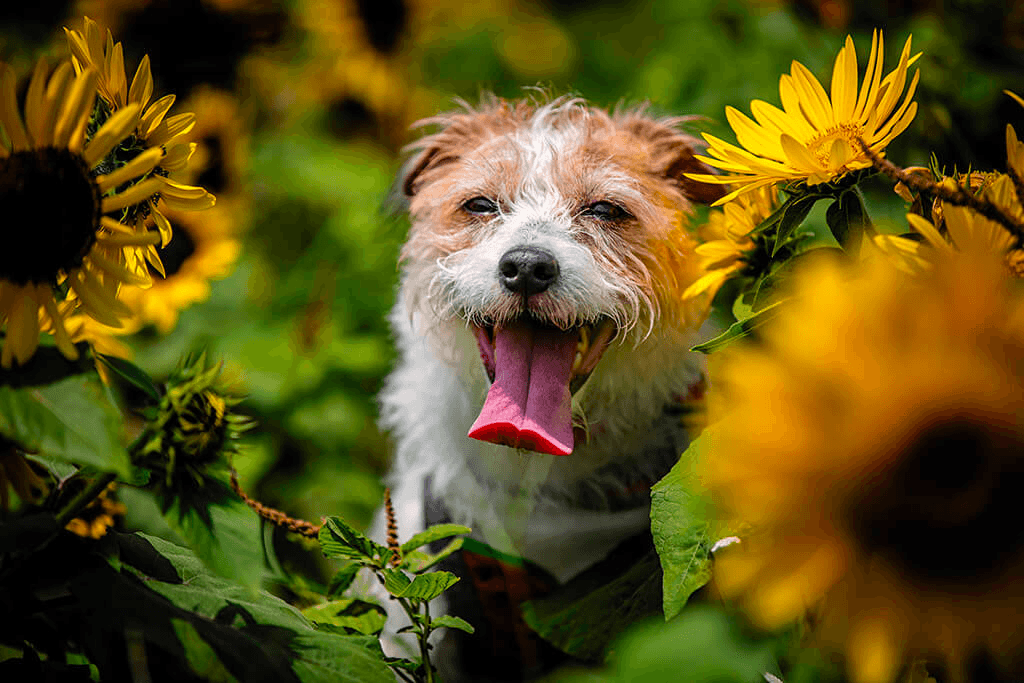In this blog, learn whether there are benefits to a raw meat diet for dogs, whether dogs can have raw meat, and if raw meat diets for dogs are actually a risky business.
Can Dogs Eat Raw Meat?

You may have heard of raw food diets for dogs. They’ve been growing in popularity over recent years, with many pet owners considering the health benefits of their dogs eating raw meat.
But why raw meat? Well, it all stems from the fact that it resembles a diet their wild ancestors would have had. However, wild dogs have a significantly shorter life expectancy than domesticated dogs, which is worth noting.
Historically, wild canines feasted on raw meat and bones, so the thought is that despite domestication, this is better for our dogs’ health. But is it?
What Is A Raw Food Diet For Dogs?
Raw food diets typically consist of:
- Raw organ meats (like kidneys and liver)
- Muscle meat, often still attached to the bone
- Raw fruit and vegetables
- Unpasteurized dairy
- Whole, uncooked bones
Feeding raw food to dogs involves careful consideration of the types of raw ingredients included to ensure a balanced diet.

Can Dogs Have Raw Meat? What You Need to Know
Yes, dogs can eat raw meat, but the real question is whether they should.
Feeding your dog a raw meat diet has gained popularity among some pet owners due to its perceived benefits, like natural enzymes and nutrients. However, it comes with significant safety and nutritional concerns that every dog owner should carefully consider.
While raw meat can be a source of protein and nutrients, it isn’t guaranteed to provide a balanced diet. Cooking meat and carbohydrates often makes food easier to digest and helps dogs absorb nutrients more efficiently.
For example, small portions of plain cooked meat, such as boiled chicken or lamb, can be offered as occasional treats, ensuring proper nutrition without the risks associated with raw food.
Specific Types of Raw Meat: What’s Safe?
Can Dogs Eat Raw Chicken Meat?
Benefits: A readily available, lean source of protein.
Risks: Raw chicken is prone to Salmonella contamination, so proper storage and handling are essential. Avoid feeding your dog chicken with bones that can splinter.
Can Dogs Eat Raw Beef?
Benefits: High in protein and nutrients like iron and zinc. Beef is red meat, high in protein, and contains essential nutrients like iron and zinc, which can support your dog’s health when fed in moderation.
Risks: Be cautious of the fat content, as overly fatty cuts can upset your dog’s stomach or lead to health issues like pancreatitis, while improperly sourced meat may harbor harmful bacteria or parasites. Always opt for high-quality, human-grade lean cuts and avoid beef with seasonings or additives.
Can Dogs Eat Raw Pork?
Benefits: Nutritional value in pork cuts, such as essential amino acids and vitamins.
Risks: Pork can carry parasites like trichinosis, which can be harmful. Always freeze pork for at least three weeks before serving to eliminate parasites.
Can Dogs Eat Raw Turkey Meat?
Benefits: A lean protein that’s rich in nutrients.
Risks: Bones can pose choking hazards or splinter, causing internal injuries. Ensure the turkey is boneless and properly handled.
Can Dogs Eat Raw Burger Meat?
Benefits: A convenient source of ground beef protein.
Risks: Many burger meats contain additives, seasonings, or fillers that are unsafe for dogs. Always check labels and use plain, unseasoned meat.
Can Dogs Eat Raw Deer Meat?
Benefits: A lean, natural protein that’s nutrient-rich.
Risks: Parasites are common in wild game. If sourcing from a hunter, ensure the meat is properly processed and frozen to eliminate any risks.

Benefits of Feeding Raw Meat to Dogs
Feeding raw meat to dogs can offer several potential benefits that many pet owners find appealing:
Improved Digestion
Raw meat contains natural enzymes that can help break down food more efficiently, leading to better digestion and nutrient absorption. This can be particularly beneficial for dogs with sensitive stomachs or digestive issues.
Increased Energy
Raw meat is rich in high-quality protein, which can provide dogs with a natural and sustained source of energy. This can be especially noticeable in active breeds or working dogs that require more stamina and endurance.
Healthier Coat and Skin
The essential fatty acids found in raw meat can promote a shiny coat and healthy skin, reducing issues like dryness and irritation. Some dog owners have reported that their pets’ coats become glossier and their skin less prone to problems after switching to a raw meat diet.
Food Allergies
A raw meat diet might offer some relief. Some dogs experience reduced allergy symptoms when fed a raw meat diet, possibly due to the elimination of certain allergens found in processed pet foods. This can lead to less itching, scratching, and overall discomfort.
Dental Health
Chewing on raw meat and bones can help reduce tartar and plaque buildup on teeth, promoting better oral hygiene. This natural cleaning action can be more effective than some commercial dental treats.
However, it’s essential to remember that these benefits are not universally accepted and can vary depending on the individual dog and the quality of the raw meat. Always consult with a veterinarian before making significant changes to your dog’s diet to ensure it meets their specific nutritional needs.
Risks and Safety Concerns of Raw Meat
While there are potential benefits to feeding raw meat to dogs, it’s crucial to be aware of the associated risks and safety concerns.
Bacterial Contamination
Raw meat can harbor harmful bacteria like Salmonella and E. coli, which can cause serious illness in both dogs and humans. This risk extends to anyone handling the raw meat, as well as surfaces and utensils used in its preparation.
Nutritional Deficiencies
A diet consisting solely of raw meat may not provide a balanced array of nutrients that dogs need to thrive. Essential vitamins and minerals might be lacking, leading to potential health problems over time. It’s important to ensure that a raw meat diet is well-rounded and meets all of a dog’s nutritional requirements.
Choking Hazards
While raw bones can help with dental health, they can also pose a choking risk, especially for smaller breeds. Additionally, raw bones can cause dental problems such as cracked teeth and gum damage if not appropriately sized or if the dog chews too aggressively.
Parasites
Raw meat can contain parasites like tapeworms and hookworms, which can infect dogs and lead to various health issues. Proper handling and sourcing of raw meat are essential to minimize this risk.
Given these risks, it’s crucial to take precautions when handling raw meat and to consult with a veterinarian before making any changes to a dog’s diet. A vet can provide guidance on how to safely incorporate raw meat into a dog’s diet and ensure it meets their nutritional needs. By being informed and cautious, pet owners can make the best decisions for their dog’s health and well-being.

Key Considerations for Feeding Raw Meat
- Hygiene Is Crucial: Raw meat preparation carries the risk of bacterial contamination, not just for your dog but for your household. Always sanitize preparation surfaces, bowls, and utensils after handling raw meat.
- Portion Size: Raw meat should be offered in moderation and as part of a balanced diet that meets your dog’s nutritional needs.
- Veterinary Guidance: Before transitioning your dog to a raw diet, consult your veterinarian or a canine nutritionist to ensure it’s suitable for their age, breed, and health status.
Cooked Meat vs. Raw Meat
Cooking meat to a safe temperature kills harmful bacteria and makes the food easier for dogs to digest. Properly cooked meat, combined with a balance of carbohydrates and other nutrients, ensures your dog receives a complete diet. If you want to include raw food in your dog’s diet, it should complement—not replace—a well-rounded meal plan.
While dogs can eat raw meat, including red meat, owners must weigh the potential risks and benefits carefully. A diet rich in raw meat may not meet all of your dog’s nutritional needs and could expose them to harmful bacteria or parasites. Always prioritize safety, hygiene, and veterinary advice when deciding whether to feed your dog raw or cooked meat.
What About Feeding Dogs Raw Vegetables?
When it comes to the raw food diet in dogs, raw vegetables are key to helping provide numerous health benefits and nutrients raw meat might not offer.
Try adding cut-up carrot, apple (without the pips!), banana, cucumber, or a handful of blueberries to their bowl to boost their fiber, antioxidant and vitamin levels! You should always try to wash fresh produce first as this will help remove any dirt or other bacteria.

What Should I Look For In A Raw Dog Food Diet?
If you want to introduce your dog to a raw food diet, stick to commercially prepared raw food that’s been researched and sourced from a reputable brand and has undergone feeding trials. This food should also meet the World Small Animal Veterinary Association (WSAVA) guidelines to ensure your dog will be being exposed to all the nutrients they need.
Feeding raw food to dogs requires careful selection of ingredients and adherence to safety guidelines to ensure a balanced and safe diet.
Before you make your decision though, it’s probably worth noting that The U.S. Food & Drug Administration (FDA), Centers for Disease Control & Prevention (CDC), and the American Veterinary Medical Association (AVMA) have all warned about the dangers of consuming raw meat. However, they have all produced safety guidelines for owners to read and adhere to so you can protect your dog and your household as best you can from the risks raw meat diets pose.
A raw food diet for dogs is typically a more expensive and time-consuming endeavor, too. Just the research, food preparation time, and space required in the fridge/freezer can be off-putting! And, overall, commercially prepared dry and wet dog food’s quality has improved substantially in recent years so you can always try looking into upping the quality of the food you’re already serving your pooch.
Final Thoughts on Raw Meat for Dogs
If you choose to include raw meat in your dog’s diet, you must be aware of the risks. Harmful bacteria, such as Salmonella and E. coli, can grow on uncooked meat, increasing the likelihood of illness or infection—not just for your dog but also for your household, as bacteria can spread from surfaces where raw meat is prepared. Proper food handling, sourcing, and hygiene are critical to minimizing these risks.
Ultimately, though, your dog’s diet should work for both you and them. As their owner, you know you’ll make the right decision that will serve both of you.
Sources
“Can Dogs Eat Raw Meat?” Purina https://www.purina.com/articles/dog/nutrition/can-dogs-eat-raw-meat
“Considering Switching to Raw Dog Food? Pros and Cons of a Raw Dog Food Diet” Millie’s Pet Services, Mar 13. 2019 https://milliespetservices.co.uk/switching-raw-dog-food-diet-pros-cons/
Author Dahlhausen, Katie PhD and Ganz, Holly PhD “Dog Gut Health: The 4 Ways to Restore It Naturally” Animal Biome, Oct 03. 2018 https://shop.animalbiome.com/blogs/pet-health/dog-gut-health-the-4-ways-to-restore-it-naturally
 B
B



